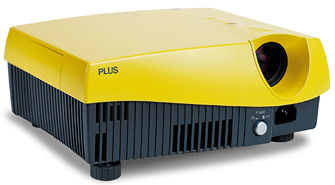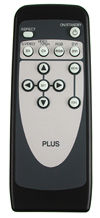PLUS Piano Avanti HE-3200 DLP Projector
You'd think there would've been a flood of entry-level DLP projectors since PLUS came out with their HE-3100 last year (see our review in the December 2001 issue). PLUS has even dropped the original Piano's price to $2,700. Usually, this would entice or force others to do likewise. There have been some new entries in the sub-$10,000 price range, but few projectors have reached below $5,000 (except for projectors aimed at the business market). This makes PLUS's step-up model, the $3,299 Piano Avanti HE-3200, even more interesting.

The HE-3200's biggest addition is HDTV compatibility. The new projector's resolution is still just 848:600 (848:480 in widescreen mode), so it won't display true high-definition images. It accepts HDTV signals at the input and downconverts them to fit the panel resolution. Even at this rate, HD images look outstanding. Unless the two were side by side, you might not notice a difference between images produced by the HE-3200 and those produced by a true high-definition display. The panel rate is also perfect for progressive-scan DVD and computer SVGA signals (the projector would present the latter in the chip's full-screen resolution of 800:600).
To help take advantage of the new capability, the projector offers component (Y/Pb/Pr), RGB, and DVI-D inputs. Given the number of new tuners with a digital video output, the latter input is a particularly welcome addition. Unfortunately, this input doesn't include HDCP, so it may not accept copy-protection-enabled DTV content. You also get S-video and composite inputs. However, due to lack of space, the HE-3200 uses the Y part of the component input as the composite input, so you'll have to use one or the other. If you need to, you can use an outboard converter to upconvert composite signals to S-video. Check with Monster Cable or Tributaries. The quality of either product's comb filter would be comparable to the HE-3200's.
Switching inputs is easy, as the minuscule remote offers discrete source buttons. Only the addition of discrete power and aspect-ratio functions could make the remote more macro-friendly. Beyond that, the remote's arrow controls guide you through the onscreen menu, which is easy to read but not always easy to configure. The HE-3200 offers various gamma choices, of which the video and PC modes should be adequate for various sources. You'll even find a number of color-space choices, which is great, since digital sources use different settings. The menu is engineeringly cryptic, and the auto mode may not get you where you need to be. If you're in the wrong mode, though, it won't matter that much.

The HE-3200's physical setup is easy, thanks mostly to its zoom lens. The DLP's unorthodox resolution makes it hard to fit all images on either a 4:3 or a 16:9 screen. With the HE-3100, you have to move the projector forward or backward to make 4:3 or 16:9 images fill the screen. With the HE-3200, you can just zoom the lens. If you opt to use the HE-3200 with a 1.42:1-shaped screen (as I suggested in my review of the HE-3100), you'll also benefit from the HE-3200's new aspect-ratio control, which is a part of the new processor chip.
 The new projector's Silicon Image Sil 504 chip still offers 3:2-pulldown detection for film-based sources; but, more importantly, it adds much-needed scaling for 4:3 letterboxed images. This means that it will stretch nonanamorphic widescreen images to fill the full 16:9 screen width. Unfortunately, the processor still won't automatically recognize a DVD's anamorphic flag, so you'll have to change the aspect ratio yourself. The 3:2 detection easily recognizes film-based sources, but our review sample did seem to introduce some banding artifacts. This was evident in the stadium seats of Video Essentials' Montage of Images and the Roman rooftops in chapter 12 of Gladiator. In fact, the banding was evident with both interlaced and progressive sources but only when displayed in 16:9 mode. In 4:3 mode, the banding wasn't present. PLUS was unable to re-create the artifact and couldn't comment. The processor did eliminate the motion artifacts that can otherwise appear in these images and did a decent job of processing video-based sources.
The new projector's Silicon Image Sil 504 chip still offers 3:2-pulldown detection for film-based sources; but, more importantly, it adds much-needed scaling for 4:3 letterboxed images. This means that it will stretch nonanamorphic widescreen images to fill the full 16:9 screen width. Unfortunately, the processor still won't automatically recognize a DVD's anamorphic flag, so you'll have to change the aspect ratio yourself. The 3:2 detection easily recognizes film-based sources, but our review sample did seem to introduce some banding artifacts. This was evident in the stadium seats of Video Essentials' Montage of Images and the Roman rooftops in chapter 12 of Gladiator. In fact, the banding was evident with both interlaced and progressive sources but only when displayed in 16:9 mode. In 4:3 mode, the banding wasn't present. PLUS was unable to re-create the artifact and couldn't comment. The processor did eliminate the motion artifacts that can otherwise appear in these images and did a decent job of processing video-based sources.
You'll also notice that the projector has an excellent color decoder and offers a vibrant picture. Colors really pop off the screen. The image also looks sharp. PLUS utilizes each of the 848 pixels across the dual-mode panel. The previously mentioned rooftops and stadium seats were clearly defined and delineated. They were significantly sharper with S-video and component images than they were with composite images. The only downside to the HE-3200's image is its black level, which isn't quite as good as that of Texas Instruments' new HD2 DLP chip. The picture isn't objectionable, though, and it still has plenty of snap, thanks to the high light output.
PLUS has done a good job of keeping the price down and the quality up when creating a step-up model to their existing Piano projector. With increased light output and the addition of HDTV compatibility, a DVI-D connector, and a more-flexible aspect-ratio control, the Avanti HE-3200 comes out looking like a grand Piano. (Get it? Heh, heh. I slay me.)

Highlights
• Accepts HDTV signals
• 3:2-pulldown detection
• Scales nonanamorphic images
- Log in or register to post comments
























































